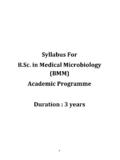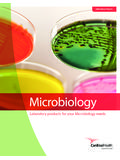Transcription of General Microbiology Laboratory Manual
1 General Microbiology Laboratory ManualBIOL 142 ByPaul W. LeppSecond EditionBiol 142 General Microbiology Spring 20102 TABLE OF SAFETY RULES PAGE INTENTIONAL LEFT BLANK TECHNIQUE AND CULTIVATION PAGE INTENTIONAL LEFT BLANK OF NORMAL FLORA PAGE INTENTIONAL LEFT BLANK GROWTH OF HAND WASHING PAGE INTENTIONAL LEFT BLANK OF MICROBIAL GROWTH PAGE INTENTIONAL LEFT BLANK OF AN UNKNOWN BACTERIUM PAGE INTENTIONAL LEFT BLANK ASSAY PAGE INTENTIONAL LEFT BLANK 78 Biol 142 General Microbiology Spring ANTIBIOTIC RESISTANCE PAGE INTENTIONAL LEFT BLANK ISOLATION PAGE INTENTIONAL LEFT BLANK TYPING 89 Biol 142 General Microbiology Spring 20104 Laboratory SAFETY
2 RULESBIOSAFETY IN THE LABORATORYB efore beginning to work with microorganisms it is important to understand the risks of working with potentially dangerous living organisms and working in a Laboratory setting in primary responsibility for your safety rests with you. You must understand and follow the rules outlined below, as well as, those provided by the instructor. The most important rule for staying safe in the Laboratory is to use your common should become familiar with the location and use of the safety equipment in the Laboratory which the instructor will point out. This includes a fire extinguisher, fire blanket, eyewash station, safety shower and gas cutoff.
3 In addition, you should be aware of all exits from the this course you will be working with microorganisms that are classifed as biosafety level I and biosafety level II organisms. Biosafety levels are established by the Center for Disease Control and Prevention. These biosafety levels are described in the section below and summarized in table 1. Bear in mind that you will be working with biosafety level II agents that have the potential to cause disease. The simplest and most effective way to prevent transmission of potentially harmful microorganisms is handwashing, as we will see in one of the following Laboratory exercises. Hands must be washed whenever you leave the Laboratory .
4 BIOSAFETY LEVELS From: Biosafety in Microbiological and Biomedical Laboratories (BMBL), 5th Edition Center for Disease Control and Prevention (CDC) Section IIIL aboratory Biosafety Level CriteriaThe essential elements of the four biosafety levels for activities involving infectious microorganisms and Laboratory animals are summarized in Table 1 of this section and Table 1. Section IV (see pages 52 and 75). The levels are designated in ascending order, by degree of protection provided to personnel, the environment, and the community. Biol 142 General Microbiology Spring 20105 BIOSAFETY LEVEL 1 (BSL-1)Biosafety Level 1 is suitable for work involving well-characterized agents not known to consistently cause disease in healthy adult humans, and of minimal potential hazard to Laboratory personnel and the environment.
5 The Laboratory is not necessarily separated from the General traffic patterns in the building. Work is generally conducted on open bench tops using standard microbiological practices. Special containment equipment or facility design is neither required nor generally used. Laboratory personnel have specific training in the procedures conducted in the Laboratory and are supervised by a scientist with General training in Microbiology or a related science. The following standard and special practices, safety equipment and facilities apply to agents assigned to Biosafety Level 1: A. Standard Microbiological Practices 1. Access to the Laboratory is limited or restricted at the discretion of the Laboratory director when experiments or work with cultures and specimens are in progress.
6 2. Persons wash their hands after they handle viable materials, after removing gloves, and before leaving the Laboratory . 3. Eating, drinking, smoking, handling contact lenses, applying cosmetics, and storing food for human use are not permitted in the work areas. Persons who wear contact lenses in laboratories should also wear goggles or a face shield. Food is stored outside the work area in cabinets or refrigerators designated and used for this purpose only. 4. Mouth pipetting is prohibited; mechanical pipetting devices are used. 5. Policies for the safe handling of sharps are instituted. 6.
7 All procedures are performed carefully to minimize the creation of splashes or aerosols. Biol 142 General Microbiology Spring 20106 7. Work surfaces are decontaminated at least once a day and after any spill of viable material. 8. All cultures, stocks, and other regulated wastes are decontaminated before disposal by an approved decontamination method such as autoclaving. Materials to be decontaminated outside of the immediate Laboratory are to be placed in a durable, leakproof container and closed for transport from the Laboratory . Materials to be decontaminated outside of the immediate Laboratory are packaged in accordance with applicable local, state, and federal regulations before removal from the facility.
8 9. A biohazard sign must be posted at the entrance to the Laboratory whenever infectious agents are present. The sign must include the name of the agent(s) in use and the name and phone number of the investigator. 10. An insect and rodent control program is in effect . B. Special Practices None C. Safety Equipment (Primary Barriers) 1. Special containment devices or equipment such as a biological safety cabinet are generally not required for manipulations of agents assigned to Biosafety Level 1. 2. It is recommended that Laboratory coats, gowns, or uniforms be worn to prevent contamination or soiling of street clothes.
9 3. Gloves should be worn if the skin on the hands is broken or if a rash is present. Alternatives to powdered latex gloves should be available. 4. Protective eyewear should be worn for conduct of procedures in which splashes of microorganisms or other hazardous materials is 142 General Microbiology Spring 20107 D. Laboratory Facilities (Secondary Barriers) 1. Laboratories should have doors for access control. 2. Each Laboratory contains a sink for handwashing. 3. The Laboratory is designed so that it can be easily cleaned. Carpets and rugs in laboratories are not appropriate.
10 4. Bench tops are impervious to water and are resistant to moderate heat and the organic solvents, acids, alkalis, and chemicals used to decontaminate the work surface and equipment. 5. Laboratory furniture is capable of supporting anticipated loading and uses. Spaces between benches, cabinets, and equipment are accessible for cleaning. 6. If the Laboratory has windows that open to the exterior, they are fitted with fly 142 General Microbiology Spring 20108 Table 1. Biosafety levelsBSL Agents Practices Safety Equipment(Primary Barriers)Facilities(Secondary Barriers)1 Not known to consistently cause disease in healthy adults Standard Microbiological Practices None required Open bench top sink required2 Associated with human disease, hazard = percutaneous injury, ingestion, mucous membrane exposure BSL-1 practice plus.




